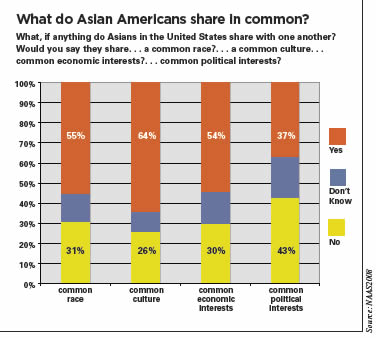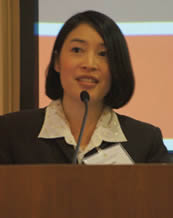By Janelle Wong


The hallmark of the Asian American community is diversity. We are made up of people who hail from distinct nations and places, we encompass many religious traditions, we speak a plethora of languages, and we represent a vast array of cultural practices and migration histories. Given these and many other distinctions that cross-cut our community, what binds us together as Asian Americans?
Although Asian Americans are classified by the census as a racial group, some might be surprised to learn that data from a national survey of more than 5,000 Asian Americans conducted in 2008 show that only 55% of Asian Americans believe that we share a common race. Asian Americans are more likely to believe we share a common culture (64%).
A fairly large chunk of Asian Americans, including more than 15% of Chinese, Indians, Koreans, and Filipinos reported experience with racially motivated discrimination in 2012. A recent Pew Survey report found that as a whole, 19% of Asian Americans say they have personally experienced racial discrimination. Despite that, other surveys show that all racial groups, including Asian Americans, believe Asian Americans face the least amount of discrimination of any group, and only 13% of AAPIs see racial discrimination as a “major” problem. Although experience with racial discrimination could serve as common ground for Asian Americans, these data suggest that it is currently regarded as an individual, rather than a group experience.
If a large majority of Asian Americans do not believe we share a common race, and if racial discrimination is not seen as a problem that affects the group as a whole, just what holds us together?
Language-access and immigration policy continue to be pressing community issues for the vast majority of Asian Americans. Not only are most Asian Americans immigrants, but 48% of Chinese, 46% of Koreans, and 60% of Vietnamese reported in 2010 that they speak English less than very well. Even 18% of the mostly U.S.-born Japanese Americans say they speak English less than very well. Across all national-origins, including Japanese Americans, and regardless of ethnicity, a majority say they continue to communicate with family and friends in the country of origin. Thus, Asian Americans share transnational social networks in common.
Asian Americans’ political energies are not spent on issues related to the country of origin. A very small proportion of Asian Americans (less than 4% of any national-origin group) actively take part in politics related to their countries of origin. Instead, they are more interested in participating in U.S. politics. Further, politics in the home country is not a distraction from U.S. politics. Those who do take part in politics related to the home country are also the most active in U.S. politics
We also share some policy attitudes according to the 2012 National Asian American Survey. Almost three out of four AAPI voters supported President Obama’s re-election last November, for instance. We support the Affordable Care Act in larger proportions than the general public and fully 60% of Asian Americans favor protecting the environment over economic growth, compared to 40% of Americans generally. On fiscal issues, Asian Americans’ attitudes converge a bit more with the general public. In 2012 surveys, about 65% of both Asian Americans and the U.S. general public believed the “federal government should raise taxes on those earning more than $250,000 a year.”
It should be clear, then, that Asian Americans have much in common in terms of experiences and attitudes. It should also be clear that these experiences and attitudes are not absolutely consistent across all national origin groups or individuals. Shared experiences and attitudes alone will not hold the Asian American community together. Organizations, advocacy groups, community leaders, and , civic, business and political infrastructures can and do provide the institutional support necessary to both cultivate and grow a sense of common Asian American identity and issues.
 Asian Fortune Your source for all things Asian American
Asian Fortune Your source for all things Asian American



